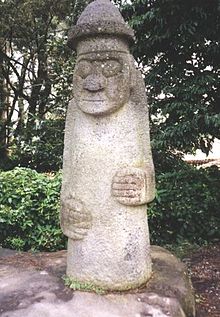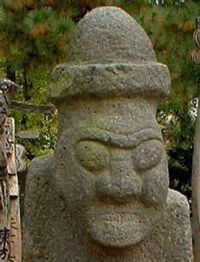- Dol hareubang
-
Dol hareubang 
A dol hareubang at Tamna Mokseokwon on Jeju Island.Korean name Hangul 돌 하르방 Revised Romanization Dol hareubang McCune–Reischauer Tol harŭbang Alternate names:
Beoksumeori (벅수머리)
Museongmok (무성목/武石木)
Useongmok (우성목/偶石木)Dol hareubangs, also called tol harubangs, hareubangs, harubangs, are large mushroom-like statues found on Jeju Island off the southern tip of Korea. They are considered to be gods offering both protection and fertility and were placed outside of gates for protection against demons travelling between realities.
Contents
Description
The dol hareubangs are carved from porous basalt (volcanic rock) and range in size up to 3 metres high. The statues' faces feature grinning expressions and bulging eyes without pupils, a long, broad nose, and slight smile and their hands rest on their bellies, one slightly above the other. In sets of two, one will have a higher left hand and the other a higher right hand. The hat is commonly referred to as phallic or mushroom-like.
Etymology
The name dol hareubang derives from the Korean word for "stone" (dol 돌) plus the Jeju dialect word hareubang (하르방) meaning "grandfather" or "senior" (harabeoji [할아버지] in Standard Korean) and was coined in the mid-20th century. Other earlier names for the statues include beoksumeori, museongmok, useongmok. Beoksumeori, meaning shaman head, is used in the former area of Jeongui Hyeon (county), museongmok in Daejeong Hyeon and Jeongui Hyeon, and useongmok only in Jeju Hyeon. Historically, the Tamna Chronicles called them ongjungseok (옹중석/翁仲石) but this usage is unknown today.
History
 A dol hareubang in the National Museum of Korea.
A dol hareubang in the National Museum of Korea.
There are three main theories as to the origin of dol hareubangs; either that they were introduced by visitors from the sea, that they are a counterpart to the jangseungs (totem poles) of mainland Korea, or that they spread with shamanic mushroom culture. Jangseungs are also called beoksu in southern Korea and this similarity with the name beoksumeori lends credence to the second and third theories.
Halla San has been named in Chinese literature as one of the "Sam Shin San" (삼신산/ 三神山), or one of the Three Spirit Mountains. Each of these mountains are considered gateways to the spirit world, and have the Amanita muscaria growing in abundance. This mushroom is well known by the Siberians and is a possible origin for the Stone Grandfather.
This theory lends that powerful shamans descending from the north established a magic mushroom cult on the island in which stone grandfathers were set at the sides of thresholds to prevent the entry of unwanted spirits.
The mushroom and its related imagery has had great importance in Korea, visible in ancient crowns, funeral urns, the Ship Jang Saeng Do (십장생도). The Dol Harubang are a form of political propaganda, representations of the sacred powers of the mushroom, its associated deity, and attesting to the power of the Shamans.
Dol hareubangs produced from 1763-1765 once stood outside the eastern, western, and southern gates of the Jeju City fortress as guardian deities.
Dolhareubangs today
Dolhareubangs have become the symbol of Jeju Island and replicas of various sizes are sold as tourist souvenirs. The statues are sometimes sold as sources of fertility and small replicas are sometimes given to women with fertility problems. The origin of this may have more to do with Jeju Do's present day status as a 'honeymoon island' than tradition.
See also
External links
- Jeju's symbol: Dolhareubang at Jeju Special Self-governing Province website
Categories:- Religion in Korea
- Religion in South Korea
- Korean culture
- Outdoor sculptures
Wikimedia Foundation. 2010.

